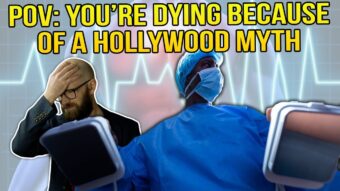
While this is how most of us picture medical resuscitation, this familiar scene is pure Hollywood, an inaccurate hodge-podge of real-life procedures supercharged for maximum dramatic impact. In addition to leaving out key steps and grossly exaggerating the actual success rate of such interventions, nearly every popular depiction of medical resuscitation gets the use of defibrillators dead wrong. Far from being magic electric boxes capable of instantly jump-starting a stopped heart, defibrillators are in fact never used in cases of cardiac arrest and are only useful for treating a narrow range of cardiac emergencies. Indeed, using a defibrillator as indiscriminately as Hollywood doctors would do far more harm to patients than good. So how, then, do these misunderstood devices actually work, and how do real-life paramedics and doctors go about saving people from the brink of death?
To understand how defibrillators work, it is first necessary to understand how the heart itself normally functions. Cardiac muscle cells are myogenic or self-exciting, meaning they are capable of rhythmically contracting on their own without receiving any signals from the nervous system. Individually, however, these cells do not follow any set rhythm; in order for the heart to function properly as a whole, the contraction of all its constituent cells must be coordinated. This is accomplished via a clump of specialized cardiac cells located in the right atrium called the sinoatrial or SA node – better known as the pacemaker. The SA node sends out a regular electric pulses, which are carried throughout the rest of the heart along special nerves known as Purkinje fibres.When the SA node fires, this pulse first travels through the atria at the top of the heart, causing them to contract and forcing blood through one-way valves into the ventricles below. The pulse then reaches another clump of nodal tissue known as the atrioventricular or AV node, which delays the pulse by 0.1 seconds before relaying it to the rest of the heart. This in turn causes ventricles to contract and pump blood to the lungs and the rest of the body. This delay is necessary to ensure that the atria are fully emptied before the ventricles contract. This entire contraction phase is known as systole, and is followed by a second phase known as diastole in which the cardiac muscle relaxes, allowing blood to flow into the atria. The SA node then fires again, and the whole cycle begins anew. It is the firing of the SA node and not the actual contraction of the heart which is detected by an electrocardiogram or EKG heart monitor.
Both the SA and AV nodes are capable of functioning on their own; indeed, if a frog’s heart is removed and placed in a saline solution, it will continue to beat with a regular rhythm for up to an hour. However, the rhythm at which the SA node fires – and thus the rate at which the heart beats – can be varied via a number of mechanisms. The autonomic nervous system, which controls the body’s non-voluntary functions like breathing and digestions, consists of two main divisions – the sympathetic and parasympathetic nervous system – which have opposing effects on heart rate. The sympathetic nervous system stimulates the SA node and increases heart rate, inducing the so-called “fight-or-flight” or “feed and breed” response; while the parasympathetic nervous system slows the heart down, inducing the “rest-and-digest” response. The SA node can also be directly stimulated by the hormone epinephrine, better known as adrenaline, which is produced by the adrenal glands atop the kidneys and is also used to induce the fight-or-flight response. Other signals which can directly stimulate the SA node and increase heart rate include increased blood flow from the venous system and increased body temperature, commonly encountered, for example, by intense exercise.
If the function of the heart’s pacemaking system is interrupted, such as by a heart attack, electric shock, injury, toxins, or disease, a variety of dangerous irregular heart rhythms or arrhythmias can result, the two most common of which are ventricular fibrillation of “v-fib” and ventricular tachycardia or “v-tac”. In ventricular fibrillation the muscles of the ventricles contract irregularly, wriggling like a bag of worms; while in ventricular tachycardia they contract uniformly but too rapidly, giving the ventricles insufficient time to fill with blood between contractions. The result in both cases is the loss of the heart’s ability to effectively pump blood, leading to hypoxia or lack of oxygen to the brain and death within minutes without medical intervention. As the name suggests, it is these kinds of arrhythmias which a defibrillator is designed to correct.
The principle of defibrillation was first demonstrated in 1899 by Jean-Louis Prévost and Frédéric Batelli, two physiologists from the University of Geneva, who discovered that small electrical shocks could induce ventricular fibrillation in dogs, while larger shocks could reverse the condition. It would not be until the 1930s, however, that pioneers like American electrical engineer William Kouwenhoven and cardiac surgeon Claude Beck began developing practical defibrillation devices for use on humans. Unlike most defibrillators we are used to seeing, these early devices were intended for use during surgery, the paddles being applied directly to the patient’s exposed heart. Beck initially conducted his defibrillation experiments on lab animals, until one day in 1947 when a 14-year-old patient went into ventricular fibrillation during surgery. In desperation, Beck ordered his crude experimental defibrillator brought up from his lab and applied two jolts to the patient’s heart. To the world’s absolute shock, the patient revived, the seemingly miraculous electrical resurrection making headlines across the nation. Yet despite this success, for years the defibrillator remained a niche device used almost exclusively during surgery. This is because early devices ran on alternating current, and the use of AC voltages high enough to reach the heart through the unopened chest resulted in a number of unpleasant side effects, including broken ribs, electrical burns, and heart damage. It was not until the mid-1950s that William Kouwenhoven, Soviet physician Naum Guerevich, and Czech physician Bohumil Peleska independently developed practical external defibrillators based on Direct Current which could be safely used without opening the patient’s chest.
Whatever the specific design, all defibrillators work the same way: by depolarizing the muscle and nerve cells of the heart and halting the arrhythmia. Much like turning off a device and turning it back on to see if it fixes it, this effectively “resets” the heart, allowing the SA and AV nodes to take over and re-establish a healthy cardiac rhythm. While the output of most defibrillators can be adjusted depending on the application, most operate in the range of 300-400 Joules. This is potentially hazardous to a healthy person; thus the cliched call of “clear!” prior to administering a shock is a warning to all bystanders to remove their hands from the patient. Combined with CPR and the administration of antiarrhythmic drugs like Procainamide, Adenosine, and Beta-blockers, timely defibrillation can improve survival rates in cases of arrhythmia to as high as 74%.
However, defibrillation works only if the heart already has its own electrical activity; in cases of asystole and pulseless electrical activity – more commonly known as cardiac arrest or flatlining – defibrillation has absolutely no effect. Yes, you heard that right: despite what nearly every movie or TV show would have you believe, defibrillators are not, in fact, capable of kickstarting a stopped heart. Nor are they particularly useful for cardiac emergencies other than ventricular fibrillation or tachycardia; indeed, using a defibrillator on the wrong cardiac rhythm can potentially make things worse, as such a powerful electric shock can actually induce a deadly arrhythmia. For this reason, real-life paramedics and emergency room doctors do not use defibrillators indiscriminately but rather wait until an EKG is hooked up to the patient to determine whether defibrillation is indicated.
But when responding to a cardiac emergency, every second counts. Following the cutoff of oxygen to the brain, a victim’s chances of survival go down by 7% every minute for the first three minutes and 10% for every minute thereafter, with a high risk of irreversible brain damage after 3-5 minutes. Thus, the need to wait for paramedics to arrive and hook up an EKG prior to administering defibrillation once resulted in an extremely low survival rate for out-of-hospital heart attacks and other cardiac emergencies. In the 1970s, this problem inspired the invention of Automated External Defibrillators or AEDs, compact units which could be placed in public areas for ready use and operated by untrained bystanders. Instead of paddles, most AEDs feature self-adhesive electrodes that are applied to the patient’s chest, while many models include pictorial instructions and even spoken prompts to guide the operator through the device’s operation. Most importantly, however, AEDs incorporate an EKG to analyze the victim’s hearth rhythm and determine whether defibrillation is required. If it is, then depending on the model the AED will either deliver the shock automatically or prompt the operator to push a button to manually administer the shock. Such quick and ready access to defibrillation has had a dramatic impact on outcomes for heart attack victims. According to the American Heart Association, prior to AEDs, the survival rate for out-of-hospital heart attacks was less than 10%, while in areas where AEDs and Cardiopulmonary Resuscitation or CPR training are prevalent, these odds have risen to nearly 40%.
While ventricular fibrillation and tachycardia are typically associated with heart attacks, electrocution, and other acute conditions, they can also be caused by chronic illnesses like coronary heart disease and cardiomyopathy. As this kind of arrhythmia is constant and recurring, sufferers are sometimes fitted with a device known as automatic an internal cardiac defibrillator or AICD. This is similar to an artificial pacemaker, an implanted electronic device which simulates the function of a faulty sinoatrial node – and indeed many AICDs are capable of performing both functions. Via electrodes implanted in the heart, the AICD is able to detect dangerous fibrillation or tachycardia and automatically administer a defibrillating shock in order to keep the wearer’s heart functioning normally.
But if defibrillation cannot restart a stopped heart, then how do paramedics and emergency room doctors respond to cases of cardiac arrest? The first priority in such situations is to maintain the flow of blood and oxygen to the brain. This is accomplished – either by trained bystanders or first responders – via Cardio-Pulmonary Resuscitation or CPR. This was yet another lifesaving innovation by the research team led by William Kouwenhoven, the early pioneer of defibrillation. In 1958, Kouwenhoven’s colleague G. Guy Knickerbocker noticed that pressing the defibrillator paddles against a dog’s heart caused the animal’s blood pressure to rise. Based on this observation, Knickerbocker and his colleagues developed a system of manual “cardiac massage” to help correct fibrillation and tachycardia or maintain circulation in surgical patients suffering from cardiac arrest. This soon evolved into a “closed chest” resuscitation method composed of rhythmic chest compressions and artificial ventilation of the patient’s lungs. Using this method, Knickerbocker was able to restore up to 40% of the patient’s circulation, keeping the brain oxygenated and buying enough time for the heart to be restarted.
While first responders and emergency room doctors typically use a mask or endotracheal tube with a hand-pumped resuscitation bag to ventilate patients, in a bystander situation this can be accomplished using artificial respiration, also known as rescue breathing or the “kiss of life.” Regular air contains about 20% oxygen, but the lungs absorb only about a quarter of this per breath, meaning that exhaled breath contains more than enough oxygen to sustain life. Currently, the American Heart Association’s CPR guidelines recommend 30 full chest compressions followed by two rescue breaths, although as we’ll get into shortly, research indicates outcomes are significantly improved by having individuals skip the breaths altogether and stick strictly to compressions only until professional help arrives.
In any event, amusingly, in order to maintain the recommended rhythm of around 100 chest compressions per minute, the AHA recommends that rescuers hum songs such as the Bee Gee’s ‘Stayin’ Alive,’ Queen’s ‘Another one Bites the Dust’, or The Clash’s ‘Should I Stay or Should I Go?’ Less amusingly, in order to adequately compress the heart through the ribcage, the AHA also recommends compressing the chest as much as 2-3 inches. Thus, real-life CPR is far less clean and tidy than depicted in films and TV, often resulting in broken ribs and other very painful injuries. Still, it’s a small price to pay for potentially stayin’ alive. And if things go the other way, well, you aren’t going to care anyway.
As previously noted, while combined chest compressions and rescue breathing have been part of the AHA’s guidelines since their introduction in 1974, more recent research suggests that the rescue breathing component may in fact be counterproductive, and that chest compressions alone may actually give a higher chance of survival than traditional CPR. For example, according to a 2008 study by Dr. Gordon Ewy of the University of Arizona College of Medicine, while survival rates for victims of out-of-hospital cardiac arrests receiving traditional CPR have remained consistently low for nearly 50 years, compression-only CPR – also known as Cardio-Cerebral Resuscitation or CCR – has been shown to improve these odds by up to 300%. But how can this be? Shouldn’t rescue breathing improve the oxygenation of the blood and thus the survival of the brain? Well, according to Ewy, artificial respiration also increases air pressure in the chest cavity, compressing blood vessels and reducing overall blood circulation. Chest compressions alone, by contrast, compress the lungs sufficiently to adequately oxygenate the blood while simultaneously maintaining blood circulation, which if stopping for breaths both stops the circulation, and it takes several compressions to build the pressure and circulation back up after, extending the blood flow interruption every breath.
But whichever method is used, CPR is only intended to maintain the patient’s circulation and stave off permanent brain damage until their heart can be restarted – a condition known in emergency medicine as return of spontaneous circulation or ROSC. While it is possible for this to occur due to the CPR itself, this is vanishingly rare, and ROSC is usually achieved naturally or through the use of various drugs. The most common drug used in resuscitation is the hormone epinephrine or adrenaline, which, as previously mentioned, directly stimulates the sinoatrial node and increases heart rate. The neurotransmitter Dopamine and the alkaloid atropine – derived from the deadly nightshade plant – are also sometimes used for this purpose. These cardiac stimulants are often used in conjunction with a variety of vasoconstricting drugs such as Vasopressin, Norepinephrine, and Dobutamine, which contract blood vessels and increase blood pressure. This is especially important when using epinephrine, as this drug is a vasodilator and can induce dangerous hypotension or low blood pressure. Sadly, however, while these drug combinations have been standard practice in emergency rooms for decades, no drug has been definitively shown to improve survival outcomes in cases of cardiac arrest, meaning that most cases of the patient’s heart spontaneously restarting are likely unrelated to medical intervention. Nonetheless, without the early and consistent application of CPR, these patients would likely not have lasted long enough for their hearts to start. According to the American Heart Association, while the survival rate for out-of-hospital cardiac arrest without intervention is around 10%, with immediate CPR intervention this increases by nearly three-fold.
So despite what movies and TV would have you believe, in real life the key to restarting a stopped heart is not some magic electrical box but rather a combination of early and sustained CPR, stimulant drugs, and a whole lot of luck. Hollywood exaggerating and distorting medical procedures for dramatic effect? Colour us absolutely shocked…
If you liked this article, you might also enjoy our new popular podcast, The BrainFood Show (iTunes, Spotify, Google Play Music, Feed), as well as:
- The Resurrectionists and the Doctors’ Mob Riot
- Will Hospitals Give Back an Amputated Limb if You Ask For It?
- How the Heart Works
- Top 5 First Aid Tricks Everyone Should Know, Part 4: CPR
Campbell, Beil, Biology, The Benjamin/Cummings Publishing Company, Inc, Menlo Park, California, 1987
Defibrillators: a Brief History, Community Heartbeat, https://www.communityheartbeat.org.uk/defibrillators-brief-history
W.B. Kouwenhoven: Reviving the Body Electric, John Hopkins University Engineering, Fall 2002, https://engineering.jhu.edu/magazine/2002/09/w-b-kouwenhoven-reviving-body-electric/#.YeCgQi1b2X1
Wagenen, Juliet Van, Who Invented the Defibrillator: the Response Tech Against Sudden Cardiac Arrest, Health Tech Magazine. August 9, 2017, https://healthtechmagazine.net/article/2017/08/defibrillator-jump-started-cardiac-arrest-survival
Benefits of Fully Automatic Defibrillators, Physio Control, http://elevaed.com/wp-content/uploads/2011/05/3309488_B_LR.pdf
Pharmacology II: Agents to Optimize Cardiac Output and Blood Pressure, Circulation, August 22, 2000, https://ift.tt/L3cBCko
Benjamin, Emelia et al, Heart Disease and Stroke Statistics – 2018 Update: a Report From the American Heart Association, January 31, 2018, https://www.ahajournals.org/doi/10.1161/CIR.0000000000000558
Ewey, Gordon et al, Cardiocerebral Resuscitation, EMS Responder, July 8, 2008, https://web.archive.org/web/20080803153326/http://www.emsresponder.com/print/Emergency–Medical-Services/CARDIOCEREBRAL-Resuscitation/1%247857
The post Hollywood Myths- How Doctors Actually Resuscitate Someone and Shocking Defibrillator Myths appeared first on Today I Found Out.



0 comments:
Post a Comment
Please ,
Don't enter span link